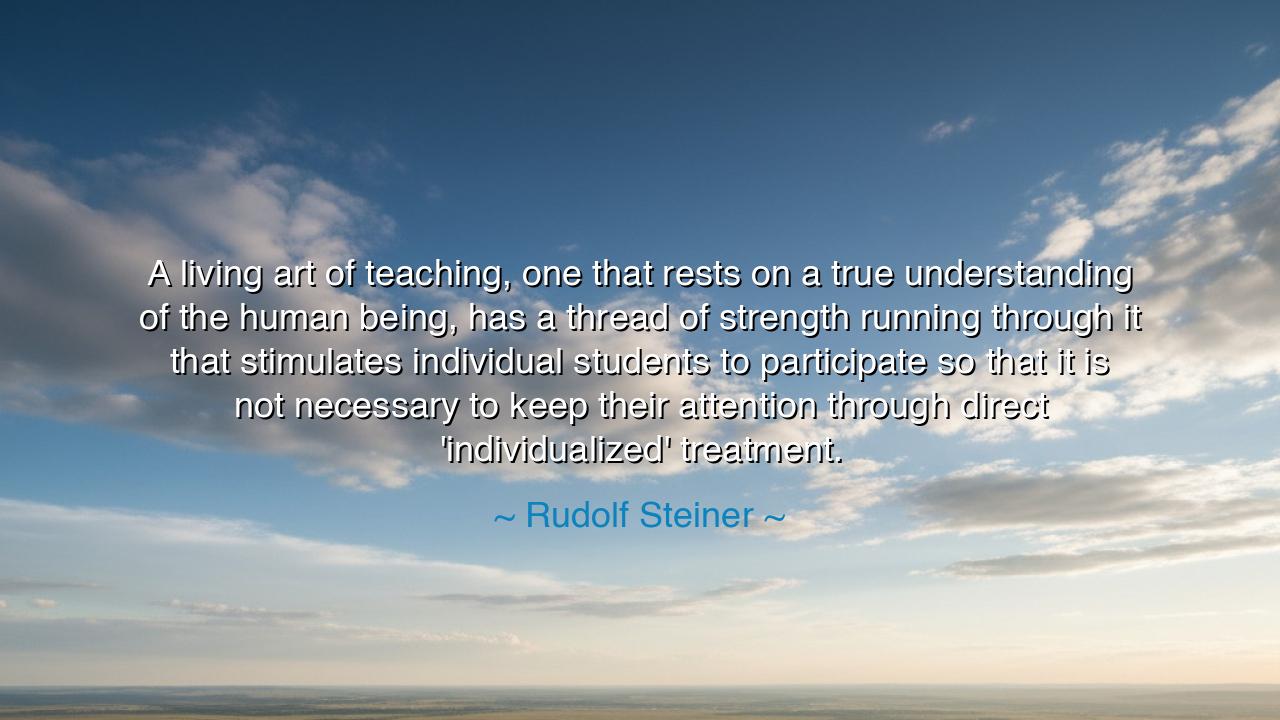
A living art of teaching, one that rests on a true understanding
A living art of teaching, one that rests on a true understanding of the human being, has a thread of strength running through it that stimulates individual students to participate so that it is not necessary to keep their attention through direct 'individualized' treatment.






Hear the voice of Rudolf Steiner, philosopher, teacher, and visionary, who proclaimed: “A living art of teaching, one that rests on a true understanding of the human being, has a thread of strength running through it that stimulates individual students to participate so that it is not necessary to keep their attention through direct ‘individualized’ treatment.” These words strike deep, for they reveal that true education is not a mechanical task of discipline and correction, but a living force that awakens the soul. To teach rightly is to know the human being in depth, to weave a thread of strength into every lesson, so that the student is moved not by compulsion but by inner participation.
The origin of this teaching lies in Steiner’s creation of the Waldorf education movement in the early twentieth century. Convinced that education must address not just the intellect but also the heart and spirit, he spoke against methods that fragmented children into problems to be managed. Instead, he envisioned a living art of teaching—dynamic, creative, holistic. In such teaching, the educator does not spend all energy chasing attention from one distracted pupil to the next. Rather, the very quality of the lesson itself, imbued with vitality and truth, draws all into its orbit. It is as if the class becomes a single stream, each student carried by its current, not because they are forced, but because they are inspired.
History gives us proof of this principle. Consider the Socrates of Athens, who never taught by rote or by individual correction, but by questions that stirred the whole gathering of youth. He possessed a thread of strength in his teaching: his ability to kindle the fire of thought. Though he addressed the group, each listener felt directly engaged, as if Socrates spoke to them alone. He did not command attention through punishment, but evoked it through the irresistible pull of inquiry. Steiner’s words reflect the same eternal law: when teaching is alive, it awakens the student from within.
The heart of Steiner’s wisdom is this: education must honor the whole human being. A child is not a vessel to be filled with facts, nor a machine to be calibrated, but a living soul that responds to beauty, rhythm, and purpose. When teaching resonates with this deeper humanity, it becomes strong and enduring. Such strength flows not from force, but from harmony with what is natural to the learner. Thus, the teacher becomes not a policeman of attention, but a guide who unlocks what already longs to awaken in the student.
There is also here a profound warning: if teaching lacks this living quality, it collapses into endless attempts at control. A lifeless lesson breeds distraction, and the teacher must then chase after each wandering mind with artificial devices of “individualized treatment.” Steiner is not scorning care for the individual, but showing that the best way to honor each person is by offering teaching that is so alive, so resonant, that each one is drawn into its flow without coercion. This is the strength of great teaching: its power to carry many without losing the individual.
Consider also the example of Maria Montessori, whose classrooms were filled with activity, but not chaos. She too discovered that when children are given meaningful, living tasks, their attention does not need to be demanded—it arises naturally. Like Steiner, she saw that when teaching touches the essence of the human being, discipline becomes unnecessary, for interest and self-mastery emerge from within. Their lives remind us that the best educators do not control their students—they liberate their inner strength.
The lesson for us is this: whether we teach in schools, in families, or in the wider world, let us make our instruction alive. Seek not to dominate minds, but to awaken them. Do not reduce individuals to problems, but call forth the greatness already within them. Cultivate a thread of strength in your own words and actions—clarity, truth, and vitality—so that others are drawn to learn, not forced.
Thus, O seeker, remember Steiner’s words: a living art of teaching transforms both teacher and student. It rests not on compulsion, but on understanding; not on control, but on inspiration. When you teach, let your lessons breathe with life, and you will find that attention flows freely, participation arises naturally, and the souls of your students awaken to their own strength. This is the way of the ancients, renewed through Steiner’s vision, and entrusted now to you.






AAdministratorAdministrator
Welcome, honored guests. Please leave a comment, we will respond soon